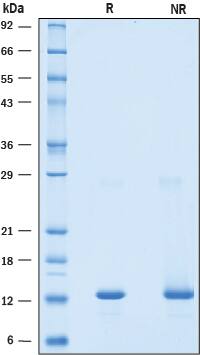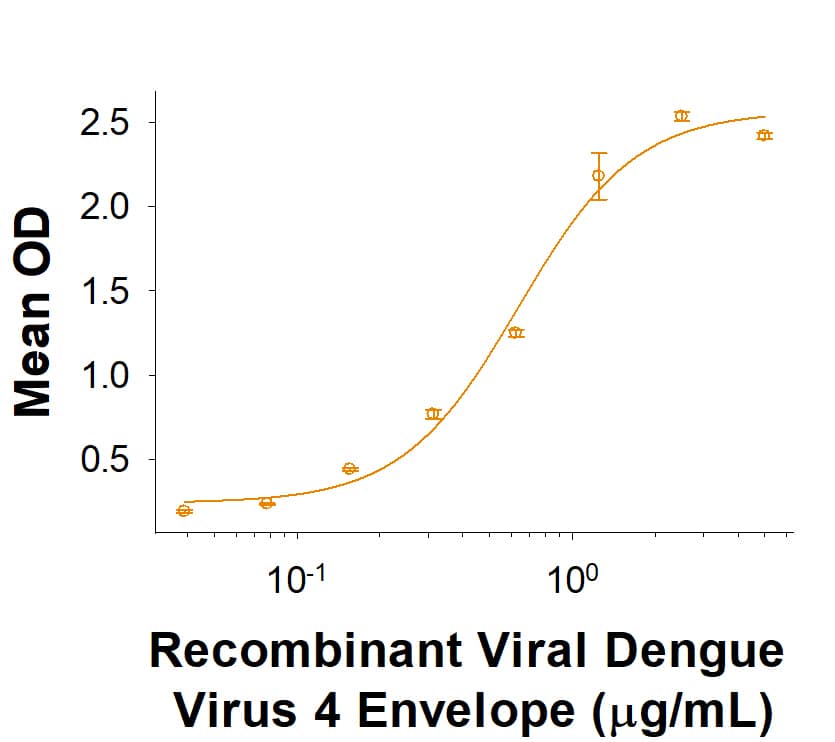Recombinant Mouse BST-2/Tetherin Protein, CF
R&D Systems, part of Bio-Techne | Catalog # 9940-BS

Key Product Details
Product Specifications
Source
E. coli-derived mouse BST-2/Tetherin protein
Thr52-Ser152, with a C-Terminal 6-His tag
Thr52-Ser152, with a C-Terminal 6-His tag
Purity
>90%, by SDS-PAGE visualized with Silver Staining and quantitative densitometry by Coomassie® Blue Staining.
Endotoxin Level
<0.10 EU per 1 μg of the protein by the LAL method.
N-terminal Sequence Analysis
Thr52
Predicted Molecular Mass
12 kDa
SDS-PAGE
13 kDa and 28 kDa, reducing conditions
Activity
Measured by its binding ability in a functional ELISA.
When Recombinant Mouse BST-2/Tetherin (Catalog # 9940-BS) is immobilized at 1 µg/mL (100 µL/well), Recombinant Viral Dengue Virus 4 Envelope Fc Chimera binds with an ED50 of 0.2-1.6 μg/mL.
When Recombinant Mouse BST-2/Tetherin (Catalog # 9940-BS) is immobilized at 1 µg/mL (100 µL/well), Recombinant Viral Dengue Virus 4 Envelope Fc Chimera binds with an ED50 of 0.2-1.6 μg/mL.
Reviewed Applications
Read 1 review rated 5 using 9940-BS in the following applications:
Scientific Data Images for Recombinant Mouse BST-2/Tetherin Protein, CF
Recombinant Mouse BST-2/Tetherin Protein Binding Activity
When Recombinant Mouse BST-2/Tetherin (Catalog # 9940-BS) is immobilized at 1 µg/mL (100 µL/well), Recombinant Viral Dengue Virus 4 Envelope Fc Chimera binds with an ED50 of 0.2-1.6 μg/mL.Recombinant Mouse BST-2/Tetherin Protein SDS-PAGE
2 μg/lane of Recombinant Mouse BST-2/Tetherin (Catalog # 9940-BS) was resolved with SDS-PAGE under reducing (R) and non-reducing (NR) conditions and visualized by Coomassie® blue staining, showing bands at 13 kDa and 28 kDa.Formulation, Preparation and Storage
9940-BS
| Formulation | Lyophilized from a 0.2 μm filtered solution in MES and NaCl with Trehalose. |
| Reconstitution | Reconstitute at 400 μg/mL in water. |
| Shipping | The product is shipped at ambient temperature. Upon receipt, store it immediately at the temperature recommended below. |
| Stability & Storage | Use a manual defrost freezer and avoid repeated freeze-thaw cycles.
|
Background: BST-2/Tetherin
References
- Evans, D.T. et al. (2010) Trens Microbiol. 18:388.
- Ohtomo, T. et al. (1999) Biochem. Biophys. Res. Commun. 258:583.
- Ishikawa, J. et al. (1995) Genomics. 26:527.
- Neil, S.J. et al. (2008) Nature. 451:425.
- Kupzig, S. et al. (2003) Traffic. 4:694.
- Janvier K. et al. (2012) Curr HIV Res. 10:315.
- Evans D.T. et al. (2010) Trends Microbiol. 18:388.
- Mahauad-Fernandez W.D. et al. (2012) Immun Inflamm Dis. 4:4.
- Swiecki M. et al. (2013) Mol Immunol. 54:132.
- Sauter D. (2014) Front Microbiol. 5:163.
- Hotter D. et al. (2013) J Mol Biol. 425:4956.
Long Name
Bone Marrow Stromal Cell Antigen 2
Alternate Names
BST2, CD317, HM1.24 Antigen, NPC-A-7, Tetherin
Gene Symbol
BST2
UniProt
Additional BST-2/Tetherin Products
Product Documents for Recombinant Mouse BST-2/Tetherin Protein, CF
Product Specific Notices for Recombinant Mouse BST-2/Tetherin Protein, CF
For research use only
